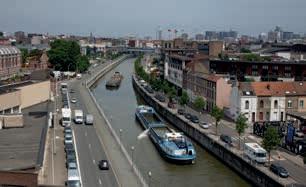
5 minute read
PORT OF BRUSSELS
INTERVIEW WITH Valérie Tanghe, Port Cluster Manager
COMPANY
Advertisement
The Port of Brussels
REGION
Brussels
Founded: 1993
Location: Brussels
Number of employees: 130
Turnover (2019): EUR 10.7 million
Growth (2019): +5.6%
Investments (2019): EUR 1,7 million
Prizes, awards: First CO2-Free Belgian Port (2019); 3-stars level Brussels Ecodynamic Company
Website: www.port.brussels
As a major economic player located in the Brussels-Capital region, the Port of Brussels is responsible for the management of a 14-kilometer-long waterway crossing Brussels from north to south and the marketing of a port estate covering 107 hectares. As the second-largest Belgian inland port situated along the Antwerp-Brussels-Charleroi waterway axis, the Port of Brussels enjoys an ideal location in the center of Europe allowing inland waterway and maritime shipping.
“By choosing Brussels as their European logistics and distribution center, companies not only benefit from the city’s central geographical position but also from its proximity to the decision-making bodies of the European Union as well as its direct multimodal connections serving major European markets such as France, Germany, the United Kingdom and the Netherlands,” explains Valérie Tanghe, Port Cluster Manager at the Port of Brussels.
In this way, by playing a key role within the European transport networks and promoting water transport as the most environment-friendly means of transport, “the Port of Brussels has set its sights on contributing to the development of combined transport in Europe and encouraging companies to opti-
mize their goods flows by undertaking a modal shift in their transportation process, from road to waterway or rail,” emphasizes Tanghe.
A LANDLORD PORT ON A TRIPLE MISSION
The Port of Brussels develops its activities around three main missions: operating the port estate, managing the port waterway network and facilitating the provision of logistics services while enhancing urban distribution.
“The Port of Brussels is the exclusive operator of the Brussels port estate. It is what is called a landlord port,” explains Tanghe. In other words, the Port remains the owner of its land and, based on concession agreements, grants plots of land to its customers, who develop an economic activity in the port estate. “Today, the Port of Brussels approximately hosts 200 companies on its estate operating in


various sectors: construction and building materials, petroleum products, container logistics, food-processing, metal recovery, and so on,” she explains.
“The second mission and a key competitive advantage of the Port of Brussels is that it is the sole manager of its waterway, unlike the great majority of other European ports,” states Tanghe. The Port consequently takes care of the maintenance and performance of the canal, its quays and its banks, two lift bridges and two locks, as well as the essential dredging of the waterway.
A third and more recent mission of the Port is that of being a logistics and mobility facilitator for the Brussels-Capital Region. “Its modern logistics infrastructure, such as a rail connection to the outer port and a trimodal container terminal (waterway, rail and road) connected to the Port of Antwerp by a river shuttle, enable the Port of Brussels to further encourage a modal shift away from the road and towards the more environmentally friendly mode of waterway transport,” continues Tanghe.
According to Tanghe, “waterway traffic has a very positive impact on mobility and the environment in Brussels. In fact, the tonnages realized in 2019 by the Port resulted in a decrease of almost 680,000 trucks on the roads, represented a CO2 emission reduction of 160,000 tons and cut external costs by EUR 27 million,” she says.
Finally, as part of its third mission, the Port also manages the TIR (Transport International Routier) Logistics Centre, “a vast complex located in the immediate vicinity of the city center, on the Port of Brussels estate, taking care of customs clearance of goods, storage and other logistical needs,” Tanghe adds.
UTCS AND UDCS
“Furthermore, the Port of Brussels intends to develop a network of urban transshipment centers (UTC) in its facilities,” says Tanghe. These platforms allow palletized goods (construction and consumer goods), as well as construction waste or containers to be unloaded from one means of transport and subsequently loaded onto another. This enables them to be transshipped closer to their final destination and end-user according to a more cost-effective last mile strategy. “Transshipment handling operations, which are also carried out at our TIR Logistics Center incidentally, are essential in our everyday port activities,” Tanghe adds.
“In fact, transshipment operations in the Port of Brussels stayed at record highs in 2019, with transshipment activities reaching more than five million
tons of freight on the Brussels port estate,” confirms Tanghe. “Building materials (62.2%) followed by oil products (21.5%) and container traffic (9.0%) are the three most important commodities in Brussels port traffic and transshipments,” she continues.
Moreover, the Port is also involved in setting up urban distribution centers (UDC) where goods supplied by boat, truck or train can be gathered and/or stored, repackaged, and then efficiently distributed in the city. “The objective of both UTCs as UDCs is therefore to optimize goods flows and reduce the distances covered by way of multimodal and sustainable transportation models,” Tanghe concludes.
EXPORTS ON THE RISE
Of the more than five million tons of freight handled by the Port of Brussels in 2019, 27% (1.4 million of tons) was destined for export. “So even though its export volume is considerably lower than its imports, the Port of Brussels did record export growth of 4% (+48,000 tons) in 2019 compared to 2018. The Port’s main trading partners were the Netherlands, Belgium’s other maritime and inland ports, and Germany,” Tanghe explains.
“This increase can be explained by the Port’s ideal geographical position and its innovative and sustainable multimodal infrastructure, which are perfectly integrated into the Trans-European Transport Network (TEN-T) and included in the North Sea-Baltic, North Sea-Mediterranean, and Rhine-Alpine Transportation Corridors,” concludes Tanghe.










